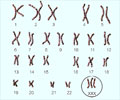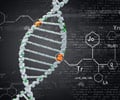The first evidence that a process of inactivating the X chromosome during embryo development and implantation takes place in human female embryos
The first evidence that a process of inactivating the X chromosome during embryo development and implantation takes place in human female embryos prior to implantation in the womb has been uncovered by Dutch researchers.
Ms Ilse van den Berg told the 25th annual meeting of the European Society of Human Reproduction and Embryology in Amsterdam today (Monday) that her findings may have implications for the laboratory cultures that embryos are grown in before transfer to a woman's womb during fertility treatment, as well as for embryo stem cell research.Males and females have two sex chromosomes: X and Y. While females have two X chromosomes and no Y chromosome, males have one of each. As the X chromosome is much larger then the Y chromosome, males and females also differ in their numbers of genes and gene expression. To equalise this difference in gene expression, females need to silence one X chromosome in every cell – a process known as X chromosome inactivation (or XCI).
In mice, XCI occurs before embryo implantation when the X chromosome inherited from the father is turned off, while the maternal X chromosome remains turned on. As the cells carry on dividing and reach the blastocyst stage, the cells that will go on to form the placenta continue to have the paternal X chromosome switched off, but it is switched back on in the cells that are going to form the inner cell mass that develops into the foetus.
"It is from these cells that mice embryonic stem cell lines are made; these ES cells have two active X chromosomes and are capable of becoming any kind of cell in the body. As soon as the cells are going to differentiate into any kind of specialised cell, one X chromosome is turned off again, but this time it is a random process and it can be either the maternal or paternal X chromosome that is switched off," explained Ms van den Berg, who is a PhD student at Erasmus Medical Centre (Rotterdam, The Netherlands).
If preimplantation XCI in mice fails for any reason, it results in cell and embryo death.
Due to the difficulties of investigating XCI in human embryos (because of the shortage of embryos available for research), no one knew how XCI worked in humans and, in fact, it was thought that this initial inactivation of the X chromosome before implantation did not happen at all, and that only the random XCI after implantation occurred.
Advertisement
The researchers looked at human embryos that had been donated for scientific research by couples undergoing fertility treatment. They studied them at three stages of their development: after the embryo had divided into eight cells, the morula stage (a solid cluster of approximately 16 cells) and the blastocyst stage (about five days after fertilisation when the embryo's cells have started to differentiate into different cell layers).
Advertisement
Ms van den Berg found that while the male embryos showed hardly any signs of XIST, the female embryos started to show signs of XIST at the eight-cell stage, and the XIST signal grew stronger at the morula and blastocyst stages.
"Our results are the first to show that, contrary to what was previously published, human embryos do inactivate a single X chromosome before implantation. We have shown that major characteristics that are present in mouse pre-implantation embryos are present also in human embryos. This means that dosage compensation is present before implantation and this could have possible implications for in vitro culture such as during IVF treatment. Furthermore, our research shows that X chromosome inactivation in humans is not very different from other placental mammals, suggesting that it has remained basically unchanged throughout evolution," said Ms van den Berg.
"Early failure to perform correct XCI is likely to lead to the demise of the embryo. A recent publication showed that the sex ratio of children born after blastocyst transfer in IVF/ICSI treatments is altered in favour of males. As a result of our finding that XCI occurs at the pre-implantation stage, further research should be able to clarify whether culture conditions in the laboratory influence the growth rate and survival of female embryos and whether this can be improved."
She said that her results also had implications for human embryo stem (ES) cell research. "Human embryonic stem cell lines are derived from blastocysts that, we know now, already have, or still have, a form of XCI. While mouse embryos reactivate the X chromosome in the inner cell mass at the blastocyst stage so that the derived embryonic stem cells are completely undifferentiated, it is not yet known whether this occurs in human embryos. The onset and subsequent steps of XCI in human pre-implantation embryos occur at a later stage than in mouse embryos. Thus, it is possible that reactivation of the X chromosome happens also at a later stage, after the usual time for ES cell derivation. The current human ES cell lines may, therefore, still have the first wave of XCI. Indeed, the majority of human ES cells have XCI features."
This might mean that human embryonic stem cells could behave in a different and possibly unpredictable way to that expected. If they are not fully undifferentiated, then they might be unable to transform completely into the particular tissues that researchers might be trying to create in the laboratory for therapeutic purposes.
"If the current human ES cell lines are in fact isolated too early, before X chromosome reactivation happens in the human blastocyst, then alternative strategies for generating human ES cell lines need to be developed. Obviously, an important step is to investigate exactly when and how reactivation of the X chromosome happens in the human embryo and to use this information in the derivation of new human ES cell lines. We are planning further research to clarify these issues," concluded Ms van den Berg.
Source-Eurekalert
RAS












